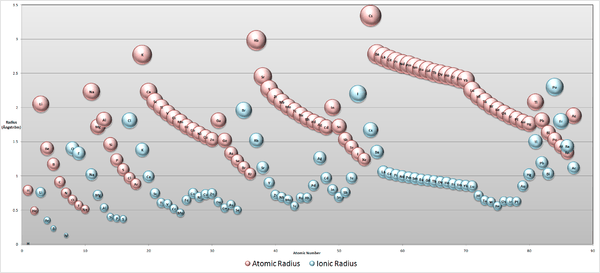Fajans' rules
In inorganic chemistry, Fajans' rules, formulated by Kazimierz Fajans in 1923,[1][2][3] are used to predict whether a chemical bond will be covalent or ionic, and depend on the charge on the cation and the relative sizes of the cation and anion. They can be summarized in the following table:

Ionic Covalent Low positive charge High positive charge Large cation Small cation Small anion Large anion
Thus sodium chloride (with a low positive charge (+1), a fairly large cation (~1 Å) and relatively small anion (0.2 Å) is ionic; but aluminium iodide (AlI3) (with a high positive charge (+3) and a large anion) is covalent.
Polarization will be increased by:
- High charge and small size of the cation
- Ionic potential Å Z+/r+ (= polarizing power)
- High charge and large size of the anion
- The polarizability of an anion is related to the deformability of its electron cloud (i.e. its "softness")
- An incomplete valence shell electron configuration
- Noble gas configuration of the cation produces better shielding and less polarizing power
- e.g. Hg2+ (r+ = 102 pm) is more polarizing than Ca2+ (r+ = 100 pm)
- Noble gas configuration of the cation produces better shielding and less polarizing power
Considering an ionic bond, in this the electron(s) is(are) not shared but transferred between the atoms conveying definite charges to each participant in the bond. The "size" of the charge depends on the number of electrons transferred so an aluminium atom with a +3 charge has a relatively large positive charge. That positive charge then exerts an attractive force on the electron cloud of the other ion, which has accepted the electrons from the aluminium (or other) positive ion.
Two contrasting examples can illustrate the variation in effects. In the case of aluminium iodide an ionic bond with much covalent character is present. In the AlI3 bonding, the aluminium gains a +3 charge. The large charge pulls on the electron cloud of the iodines. Now, if we consider the iodine atom, we see that it is relatively large and thus the outer shell electrons are relatively well shielded from the nuclear charge. In this case, the aluminium ion's charge will "tug" on the electron cloud of iodine, drawing it closer to itself. As the electron cloud of the iodine nears the aluminium atom, the negative charge of the electron cloud "cancels" out the positive charge of the aluminium cation. This produces an ionic bond with covalent character.
Now, if we take a different example, for example AlF3. We see that a similar situation occurs, but instead of iodine we now have fluorine, a relatively small highly electronegative atom. The fluorine's electron cloud is definitely less shielded from the nuclear charge and will thus be less polarizable. Thus, we get an ionic compound (metal bonded to a nonmetal) with slight covalent character.
References
- ↑ Fajans, K. (1923). "Struktur und Deformation der Elektronenhüllen in ihrer Bedeutung für die chemischen und optischen Eigenschaften anorganischer Verbindungen". Naturwiss. 11 (10): 165–72. Bibcode:1923NW.....11..165F. doi:10.1007/BF01552365.
- ↑ Fajans, K.; Joos, G (1924). "Molrefraktion von Ionen und Molekülen im Lichte der Atomstruktur". Z. Phys. 23: 1–46. Bibcode:1924ZPhy...23....1F. doi:10.1007/BF01327574.
- ↑ Fajans, K. (1924). "II. Die Eigenschaften salzartiger Verbindungen und Atombau". Z. Kristallogr. 61 (1): 18–48. doi:10.1524/zkri.1924.61.1.18.
External links
- Adrian Faiers. "Chapter 4: Chemical Bonding". Chemistry in Perspective. chembook.co.uk.